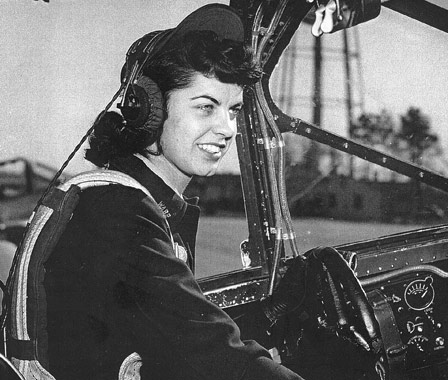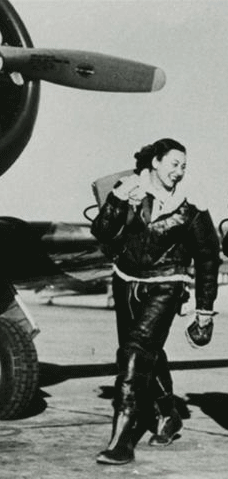The Women Airforce Service Pilots (WASP) was a pioneering organization of civilian female pilots employed to fly military aircraft under the direction of the U.S. Army Air Forces during World War II. The female pilots, trained at Avenger Field in Sweetwater, Texas, would end up numbering over 1,000, each freeing a male pilot for combat service and duties. They received training as aviation cadets with no combat or gunnery training, but were expected to fly maneuvers that were necessary to recover from any position.
These women were the first women in history to fly military aircraft and paved the way for every female military pilot who is serving our country today. We most likely would not have female pilots in the military without the special passion and dedication of these women who flew over 60 million miles in World War II.
More than 65 years ago, the WASPs flew fighter, bomber, transport, and training aircraft in defense of America’s freedom while facing incredible cultural and gender bias against women in nontraditional roles, while overcoming multiple injustices and inequities in order to serve their country. These women chose not to be ordinary but were pathfinders who wanted to serve their country by flying aircraft. Well, that was not heard of in the ’40s. Through their actions, the WASP eventually was the catalyst for revolutionary reform in the integration of female pilots into the armed services.
During the early months of World War II, there was a severe shortage of combat pilots; however, Jacqueline Cochran, America’s leading female pilot of the time, convinced Gen. Hap Arnold, chief of the Army Air Forces, that women, if given the same training as men, would be equally capable of flying military aircraft and could then take over some of the stateside military flying jobs, thereby releasing hundreds of male pilots for combat duty. It became clear to Gen. Arnold that the severe loss of male combat pilots made the necessity of utilizing women as pilots to help in the war effort; a women’s pilot training program was soon approved. It was not until August 1943 when the female aviators would receive their official name.

WASP Betty Jo Reed
Gen. Arnold ordered that all female pilots flying military aircraft, including 28 civilian ferry pilots, would be named “WASP,” Women Airforce Service Pilots. More than 25,000 American women applied for training, but only 1,830 were accepted and took the oath. Exactly 1,074 of those trainees successfully completed the 21 to 27 weeks of Army Air Forces flight training, graduated and received their Army Air Forces orders to report to their assigned air base.
Then, on Nov. 16, 1942, the first class of 29 female pilots reported to the Houston, Texas Municipal Airport and began the same military flight training as the male Army Air Forces cadets. Due to a lack of adequate facilities at the airport, three months later the training program was moved to Avenger Field in Sweetwater, Texas. The WASP was eventually stationed at 120 Army air bases all across America, and they flew more than 60 million miles for their country in every type of aircraft and on every type of assignment flown by the male Army Air Forces pilots, except combat.
The WASP assignments included test piloting, instructor piloting, towing targets for air-to-air gunnery practice, ground-to-air anti-aircraft practice, ferrying, transporting personnel and cargo (including parts for the atomic bomb), simulated strafing, smoke laying, night tracking, and flying drones. In October 1943, male pilots were refusing to fly the B–26 Martin Marauder (known as the “Widowmaker”) because of its fatality records, and Gen. Arnold ordered WASP Director, Jacqueline Cochran, to select 25 WASP to be trained to fly the B–26 to prove to the male pilots that it was safe to fly.
During the existence of the WASP, 38 women lost their lives while serving their country. Their bodies were sent home in poorly crafted pine boxes. Their burial was at the expense of their families or classmates. In fact, there were no gold stars allowed in their parents’ windows; and because they were not considered military, no American flags were allowed on their coffins.
In 1944, Gen. Arnold made a personal request to Congress to militarize the WASP, and it was denied. Then, on Dec. 7, 1944, in a speech to the last graduating class of WASP, General Arnold said: “You and more than 900 of your sisters have shown you can fly wingtip to wingtip with your brothers. I salute you … We of the Army Air Force are proud of you. We will never forget our debt to you.” With victory in World War II almost certain, on Dec. 20, 1944, the WASP was quietly and unceremoniously disbanded.
There were no honors, no benefits, and very few “thank-yous.” In fact, just as they had paid their own way to enter training, they had to pay their own way back home after their honorable service to the military. The WASP military records were immediately sealed, stamped “classified” or “secret,” and filed away in government archives, unavailable to the historians who wrote the history of World War II or the scholars who compiled the history text books used today, with many of the records not declassified until the 1980s.
As a result, the WASP story is a missing chapter in the history of the Air Force, the history of aviation, and the history of the United States of America. In 1977, 33 years after the WASP were disbanded, Congress finally voted to give the WASP the veteran status they had earned, but these heroic pilots were not invited to the signing ceremony at the White House, and it was not until seven years later that their medals were delivered in the mail in plain brown envelopes. In the late 1970s, more than 30 years after the WASP flew in World War II, women were finally permitted to attend military pilot training in the United States Armed Forces.
Thousands of female aviators flying support aircraft have benefitted from the service of the WASP and followed in their footsteps. In 1993, the WASP were once again referenced during congressional hearings regarding the contributions that women could make to the military, which eventually led to women being able to fly military fighter, bomber and attack aircraft in combat. Hundreds of United States servicewomen combat pilots have seized the opportunity to fly fighter aircraft in recent conflicts, all thanks to the pioneering steps taken by the WASP.
The WASP maintained a tight-knit community, forged by the common experiences of serving their country during war — and now the Fly Girls are coming to Sandpoint, Idaho, and will be honored! On Saturday, July 17, 2010, you will have the opportunity to meet them, to shake their hands, obtain their autographs and listen to some of their incredible stories. Most of all, the Bird Aviation Museum and Invention Center honors all of those who have served in the military, past, present and future, while giving you the opportunity say "THANK YOU" over 65 years later!
For additional information, please call 208-255-4321 or visit www.birdaviationmuseum.com.
|


